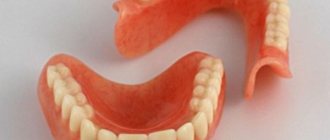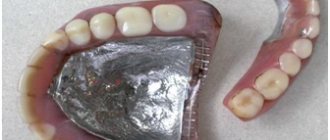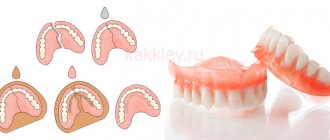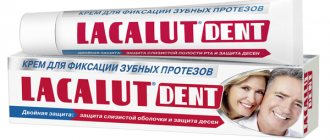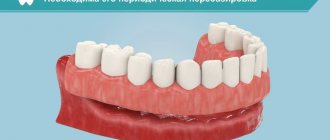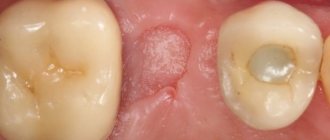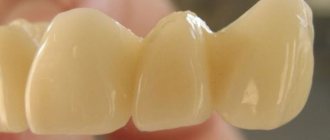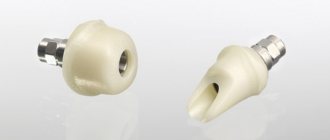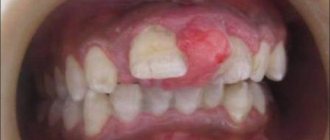Appearance and functionality
Dental crowns made of metal-plastic resemble a natural tooth in both appearance and shape. By design, it is a metal frame, which is “lined” with plastic. Such crowns are installed for a short period of time. They are mainly used for so-called immediate prosthetics.
You need to understand that constant mechanical impact on the crown will have a very bad effect. But with its help you can replace not only one lost tooth, but also an entire group, for example, the front ones. Typically, a metal-plastic crown is used so that the base is protected from mechanical impact after turning and before installing a permanent structure. If the tooth is completely lost, such a strip will prevent resorption of the alveolar bone.
Dentists recommend leaving metal-plastic crowns for no more than three months. However, many patients want to see them as their permanent teeth. Deformation does not scare them, but the low price is very attractive. It is important to understand: the main problem is the risk of caries and periodontal disease, which increases several times when wearing such crowns on an ongoing basis.
Installation steps
Before installing metal-plastic crowns, it is necessary to cure all carious diseases in the oral cavity. This will help avoid serious problems when wearing dentures.
First, the crown is installed for a short period, about two to three weeks. Fixation occurs with the help of temporary cement, which then allows you to remove the prosthesis without any problems.
During this period of time, the doctor observes the reaction of the oral cavity to the metal-plastic crown. It is possible to develop an allergic reaction or destruction of supporting teeth.
If at the end of this period the doctor finds no violations, the crown is removed and cleared of temporary cement. They also clean the oral cavity and check the condition of healthy teeth that were under the crown.
If the supporting teeth are in good condition, the metal-plastic crown is fixed with permanent cement. Excess of it must also be removed from the oral cavity.
Getting used to it can take a long time, about two to four weeks. During this period, you may experience discomfort in the mouth, slight bleeding of the gums and speech defects are possible.
For information on the indications for installing crowns and the stages of the procedure, watch the video.
Varieties and stages of production
Today there are two types of such crowns: stamped and cast. The first is a pre-made option, when the prosthesis is made according to a template. Blanks are used on which molten plastic is applied. It is exposed to a special lamp so that the mass hardens. Such prostheses are always available, so the prosthetist can install them quickly enough. True, the structure will have an uneven edge, which means the fit to the gum line will not be tight enough. Because of this, tooth decay can develop over time.
Cast crowns are made according to all the rules: a wax impression is taken, and a metal frame is made from it, onto which plastic is poured. For the base, you can use non-standard material, such as an alloy of cobalt and chromium, or gold. It is more aesthetically pleasing and safer, but takes longer to manufacture, by applying plastic only to the outer part of the base.
Cast crowns are installed like all others. They can also be placed on temporary cement before being permanently fixed.
The stages of manufacturing cast crowns are as follows:
- Using local anesthesia, the doctor prepares one or more teeth.
- The appropriate shade of plastic is determined.
- An impression is made.
- Dentures are made and fixed to the supporting teeth.
According to patient reviews, such crowns do not feel like something alien in the mouth, they are generally quite pleasant and there is no foreign feeling. They can be placed when a person has basically healthy teeth and a strong jaw frame. However, you definitely shouldn’t expect them to last long.
Manufacturing technology
Based on the manufacturing method, metal-plastic crowns are divided into two types: stamped or cast structures.
Metal alloys are used for cast crowns. First, the teeth are ground, that is, some of the hard tissue is removed.
This is done to ensure that the denture is firmly fixed in the oral cavity, as well as for a more natural appearance. There are several manufacturing stages:
- The doctor takes an impression of the dentition using special quick-hardening impression materials and passes this impression into the hands of a dental technician.
- first makes a plaster model using an impression . It is an exact copy of the patient's oral cavity.
- A metal frame is created based on the cast .
- Before finishing the production of prostheses, it is necessary to try them on . In this case, the metal base is adjusted to the anatomical features of the patient.
- If the patient and doctor are satisfied with everything, then the dental technician begins to cover this frame with plastic , which is also carefully selected individually in color.
Cast crowns are used much more often than stamped products. This is due to the fact that cast dentures closely replicate the anatomical features of the patient’s dentition.
This indicator allows you to achieve not only a natural look, but also to avoid discomfort for the patient.
Stamped crowns are made from pre-prepared standard blanks. This does not allow the denture to look natural.
The patient faces many problems. One of the most common problems is that the crowns lag behind the gums, which leads to the accumulation of food debris. Bacteria begin to multiply quickly and release toxic substances. Various oral diseases occur.
Therefore, stamped metal-plastic crowns are practically not used in modern practice. But they are much cheaper to manufacture than cast ones.
Advantages and disadvantages
Knowing all the advantages and disadvantages of metal-plastic crowns, it is easier to make a choice and subsequently care for them.
Positive qualities include the following:
- Installation speed. Usually, a good dental office has a ready-made template crown for any tooth, which can and should be installed immediately after preparation for prosthetics has been completed.
- Due to the versatility of the material, it can be used to replace either a single tooth or install an entire bridge. The latter can be of a fixed or removable type.
- Speed of production. If the finished product is not in the dental office, it will be made in just a couple of days.
- Installation of such a prosthesis has a minimal risk of damage to the mucosa, so it is practically non-traumatic. That is why doctors choose such prosthetics for patients who have increased sensitivity of the gum tissue.
- Good fixation of the prosthesis.
Today, it is plastic that makes it possible to restore teeth in the most budget-friendly option. However, such prostheses have not only obvious advantages, but also certain disadvantages:
- For people for whom appearance is important, it is better to choose another prosthetic option, since plastic does not always convey the required shade. In addition, if you often use coloring products, you need to be prepared for the appearance of the tooth to change color.
- To achieve a natural look, the plastic is applied in a very thick layer, so the base tooth is always ground down more than with other types of prosthetics. Otherwise, the metal-plastic material would stand out too much.
- Due to the fact that metal and plastic are poorly bonded to each other, there is a high risk of chipping.
They will not look this beautiful for very long.
Despite the fact that in almost all characteristics metal-plastic teeth are inferior to other types of prosthetics, due to their low cost they are often preferred by patients. Although the last word should remain with the dentist. However, if you take good care of them, rely on indications and contraindications, cast crowns can last a decent period, all other things being equal.
Despite the fact that the material’s resistance to external influences is low, and the plastic filling is poorly connected to the metal frame, if you treat such a tooth well, you can “carry” it for up to 2 years. Although there are reviews that say that 5 years is not the limit. True, this is the case if a person is ready to accept a greatly changed tooth color and the fact that it is slightly (or not slightly) deformed.
Indications for use
Dental indications include:
- missing one or more teeth;
- increased abrasion of tooth enamel;
- high sensitivity;
- the tooth being restored is destroyed by more than 70%;
- protection of dead teeth (pulpless) from destruction;
- aesthetic defects of the dentition;
- implantation in the oral cavity.
Find out more about modern treatment of wedge-shaped dental defects depending on the degree of damage. Click here to get information on how much dental braces cost from well-known manufacturers.
Follow the link https://dr-zubov.ru/xirurgiya/udalenie-zubov/slozhnosti-i-posledstviya-mudrosti.html - here you can find interesting material about the possible consequences of wisdom tooth removal.
Rules of care
If you follow basic care rules, the life of the prosthesis can be significantly extended. A person who has firmly decided on metal-plastic dental crowns should adhere to the following:
- Brush your teeth not twice a day, but every time after eating. Since the material is very porous, it quickly absorbs pathogenic organisms.
- Completely avoid or at least minimize the presence of drinks and food in your diet that contain coloring pigments, otherwise the crown will quickly lose its attractive appearance.
- The brush that will be used to clean your teeth should have soft bristles. A hard one will quickly erase the plastic, making the surface uneven.
- Be sure to use dental floss. The interdental space should be cleaned very well.
- Visit your dentist regularly. Over time, the edge of the crown wears away, and this can lead to severe injury to the mucous membrane.
- To avoid periodontal diseases, in addition to local therapy, you should take vitamin complexes, which will increase the body's immunity and resistance.
Disadvantages of the type of bridge prosthetics
Represented by the following plastic differences:
- The porous structure of the material absorbs aggressive food dyes, and the color of the crowns that make up the bridge changes and darkens.
- Not too high strength of the plastic cladding leads to chips in case of excessive loads. Therefore, clinic patients with metal-plastic prostheses abstain from solid food.
- The edges of the teeth wear down over a long period of “use.” This causes discomfort when chewing.
- The bridge has a shorter working life compared to other fixed prostheses. It is used as a temporary measure.
If the Center’s doctor decides to install a metal-plastic bridge, first of all it is necessary to verify the condition of the gums and supporting teeth. They undergo depulpation and root canal filling. The doctor grinds down the teeth for further fixation of the prosthesis on them.
The laboratory stage of bridge prosthetics begins: based on the data obtained from scanning and x-rays, a 3D model of the future tooth is created.
Caring for metal-plastic bridges includes mandatory rinsing of the mouth to reduce the impact of dyes. Avoid solid foods and visit your dentist regularly.
If the orthopedists of the ROOTT clinic identify indications for metal-plastic prosthetics, you are confident in the result.
Expert of the article Alekperov Roman Borisovich Dentist-orthopedist, doctor of the first category
Work experience 24 years.
Sign up for a consultation
three ROOTT specialists + diagnostics as a gift
All specialists Our specialists
Having extensive experience in prosthetics, the specialists of the ROOTT clinic offer an excellent solution for restoring lost teeth based on implants - a metal-plastic prosthesis, as a budget tool for replacement dentistry.
Tatyana Anatolyevna Argunova (Sivova)
dentist-therapist
0:45
Voznyuk Vladimir Alexandrovich
maxillofacial surgeon-implantologist of the highest category
Patient reviews
The decision to save on a tooth that is “not visible” resulted in having to pay twice. It chipped quickly and lost its nice color, since I am a big coffee lover.
Marina
I don’t complain about metal-plastic and have never regretted that I didn’t covet something more expensive. It’s been standing for two years now and at least he doesn’t care. Looks good, the results of the examination at the dentist are encouraging. And this despite the fact that it cost much less and the finished tooth was made in less than a week.
Vladimir
Resin bridges were a bad idea.
Maybe it’s normal with one or two teeth, but I had several replaced at once, now I have to go to the doctor again. Everything started to change and my teeth felt somewhat unpleasant to the touch. Maksim
